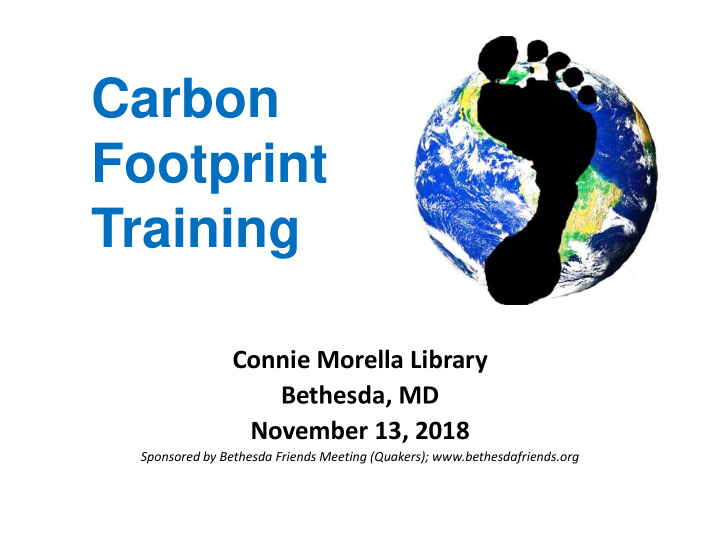



Carbon Footprint Training Connie Morella Library Bethesda, MD November 13, 2018 Sponsored by Bethesda Friends Meeting (Quakers); www.bethesdafriends.org
Presenters Rick Morgan Keith Campbell • • Commissioner, DC Public Service Data scientist specializing in Commission, 2003-2011 (retired) transportation • • Economist; Creator of EPA’s “ eGRID ” Ph.D in Systems Engineering from database of US power plants Univ. of Pennsylvania • • Member, Unity with Nature Works for MITRE Corporation Committee, Baltimore Yearly Meeting (Quakers) 2
The context for carbon footprinting • 2015 Paris Climate Accords – 196 nations signed • UN IPCC report warned last month: – Warming mustn’t exceed 1.5°C! • Atmospheric CO 2 has topped 400 ppm . → Many motivated to track carbon footprints for: – Households, congregations, communities 3
Comparing our carbon footprints worldwide Annual U.S. per capita carbon emissions (~16 metric tons) are: • Nearly double most European countries’. • 4 times worldwide average (~4 metric tons per capita). • 8 times our fair share of carbon the earth can sequester*. *~2.0 metric tons per capita annually, per 2015 Paris Climate Accords 4 Source: Stanford Kay
Climate queries posed by Friends • As a human community, do we need to limit our human caused CO 2 to equal or less than what can be sequestered? • Do we as individuals and nations need to share the limits of emissions fairly to avoid further CO 2 increases to the atmosphere? --Unity with Nature Committee Baltimore Yearly Meeting (Quakers) 5
Reasons for footprinting • Tracking our carbon footprints is a form of witness to our own actions that impact the earth. • Footprinting can motivate us to: – make changes in our personal lifestyles. – work for cultural changes. • Results are eye-opening! “When I can see my own footprint, I can’t be silent and complicit!” 6
What makes a good carbon footprint calculator? • Key attributes of a good calculator include: – user-friendliness --accuracy – robustness --usefulness of results • No single calculator ideal in all respects. – Often tension between simplicity and accuracy. • Typical features: – Organized by sector modules (travel, housing, diet, etc). – Scores generally reported by household , not per capita. – Scores expressed in metric tons of CO2 annually • 1 metric ton = ~1.1 “short” US ton. 7
A leading on-line calculator: UC- Berkeley’s CoolClimate* • Precise & easy to use • Choice of standard vs. advanced inputs • Air travel module accounts for high-altitude emissions • Documentation is thorough, transparent • ‘Take Action’ list * https://coolclimate.berkeley.edu/calculator Phone-friendly version: https://www.nature.org/en-us/get- involved/how-to-help/consider-your- impact/carbon-calculator/ 8
carbonfootprint.com (U.K.) • Versatile & easy to use • Optional high altitude adjustment for air travel • Score compared to your fair share of worldwide emissions target. • Hawking of “carbon offsets” may be objectionable to some. 9
Cool Congregations* (Interfaith Power & Light) • Calculates footprints for religious congregations • Accounts for energy use, staff travel • Estimates emissions associated with food, office products, cleaning products • Credit for congregation lands managed in their natural state * http://www.coolcongregations.org/calculator/ 10
Takeaways re: carbon footprints • Our carbon footprints are driven by our culture. – Societal infrastructure reinforces consumptive lifestyles. – Modifying behavior alone won’t solve climate change. → Work for societal change! • Still plenty of things you can control. – energy --travel – diet --purchases 11
Take action, beginning today • Caring about this issue is not enough. • Your individual actions are one important part of a larger solution. • Let’s look at some simple ways to cut your household’s footprint by 1+, 5+ and 10+ tons per year. 12
Cut your footprint at least 1 ton Switch to LED bulbs Switch to Low-Flow Shower Heads (30+ bulbs) Now less than $2 per bulb. Good models provide a nice shower. Save money! Much better than the 1980’s version. More comfort in summer! • Cut a round-trip flight to Atlanta , Chicago or Toronto. • Stop eating beef and pork in a 2-person household. • Switch to high-efficiency water heater or front-load washing machine. • Many more! 13
Cut your footprint at least 5 tons Change Electricity Provider Seal and Insulate • e.g. solar and wind plans • Improves comfort too! • Easy to switch • Most effective for older, single • Rates very close to PEPCO’s family homes. • 10+ tons for some households • Cut a 2-person flight to California or Europe. • Switch 2 vehicles to hybrid cars, or 1 car to transit. • Install solar panels. • Many more! 14
Cut your footprint at least 10 tons Cut a 4-person trip to Europe or Switch 2 vehicles to transit, EV, 2-person trip to Asia. or bicycle Combine Actions • Electrify gas appliances. • Move to a smaller place. • Many more! 15
Sample Utility Bills for Footprint 16
Recommend
More recommend